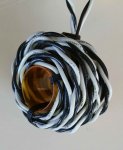You can measure the current through the EGC, and if you find it's significant then you can probably use that to help track down the issue. However, it may not account for all of the leakage current that could be tripping a GFCI. For example, if a fixture was attached to building steel then that could also be a return path for some leakage current from the fixture. Also, there might be leakage to ground along the wiring path where the leakage current is not returning through the EGC.
If you have a sufficiently sensitive clamp meter you can put the clamp over all of the conductors fed by the GFCI breaker and then use it to measure the actual leakage current the breaker is sensing. Unfortunately such clamp meters are somewhat specialized and less commonly available.
However, it's possible to increase the sensitivity of a clamp meter by putting multiple turns of the conductors through the clamp. Below is a picture of what I did by winding 10 turns of a twisted pair around a plastic tube (cut from a prescription vial). This increases the magnetic field produced by the current by ~10 times and therefore the reading on the meter by 10 times. With this contraption my clamp meter was able to measure the 8 mA leakage current when the test button of a GFCI receptacle was pressed, whereas before I measured nothing. I probably only had a resolution of about 1 mA, but this was still a big improvement.
The twisted pair keeps the differential mode component of the current (for example, a relatively large current feeding a load) from coupling a magnetic field to the clamp and giving a false reading of the common mode current, which is what we want to measure. I used a heater which draws about 11A as a load on the coil, and it had no effect on the clamp meter reading when I turned the heater ON. This confirmed that I had sufficient rejection of the load current when using this coil with the clamp meter.
...
...



